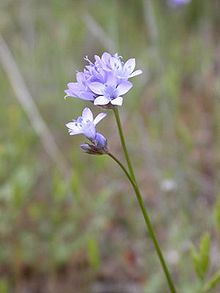
Satureja is a genus of aromatic plants of the family Lamiaceae, related to rosemary and thyme. It is native to southern and southeastern Europe, North Africa, the Middle East, and Central Asia. Historically, Satureja was defined broadly and many species of the subtribe Menthinae from throughout the world were included in it. In the modern cladistic era of botany, Satureja was redefined to a narrower monophyletic genus whose species are all native to Eurasia. Several species are cultivated as culinary herbs called savory, and they have become established in the wild in a few places.

Boraginaceae, the borage or forget-me-notfamily, includes about 2,000 species of shrubs, trees, and herbs in 146 to 154 genera with a worldwide distribution.

Lupinus, commonly known as lupin, lupine, or regionally bluebonnet, is a genus of plants in the legume family Fabaceae. The genus includes over 199 species, with centres of diversity in North and South America. Smaller centres occur in North Africa and the Mediterranean. They are widely cultivated, both as a food source and as ornamental plants, but are invasive to some areas.

The Polemoniaceae are a family of flowering plants consisting of about 27 genera with 270–400 species of annuals and perennials native to the Northern Hemisphere and South America, with the center of diversity in western North America.

Calandrinia is a genus of flowering plants known as purslanes and redmaids. It includes 37 species of annual and perennial herbs which bear colorful flowers in shades of red to purple and white. Species of this genus are native to the Americas, including western and southern South America, Central America, and western North America. Some species have been introduced to parts of Australia, New Zealand, southern Africa, Asia, and Europe. Over 60 species native to Australia and New Guinea that were formerly included in Calandrinia are now placed in a separate genus, Rumicastrum or Parakeelya. A single eastern Australian species named in 2022, Calandrinia petrophila, is still included in Calandrinia, but will be placed into the Australian genus when the name of the new genus is finally settled.

Lomatium is a genus in the family Apiaceae. It consists of about 100 species. Its common names include biscuitroot, Indian parsley, and desert parsley. It is in the family Apiaceae and therefore related to many familiar edible species such as carrots and celery. Native to western Northern America and northern Mexico, some Lomatium species are extensively used by Native Americans in the inland Pacific Northwest as a staple food.

Linanthus is a genus of annual and perennial plants in the phlox family Polemoniaceae. The species are found in western North America and in Chile, with the greatest diversity in California.

Hackelia (stickseeds) is a genus of plants in the borage family, Boraginaceae. It includes 54 species found in North America, western South America, temperate Eurasia, and Australia. 12 species are native to California.
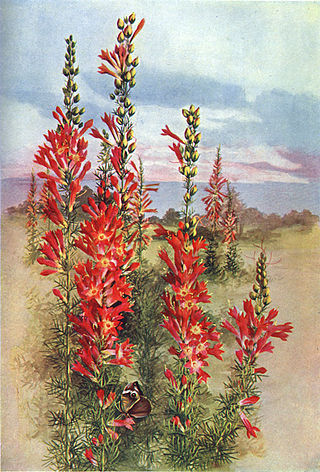
Ipomopsis is a genus of flowering plants in the phlox family, Polemoniaceae. The annual and perennial herbs it contains are native to the Americas, particularly North America.
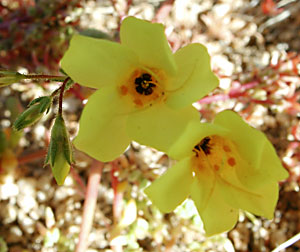
Leptosiphon is a genus of flowering plants in the Polemoniaceae family. Many included species were formerly classified as members of the genus Linanthus. Some species of this genus are grown as ornamental plants.
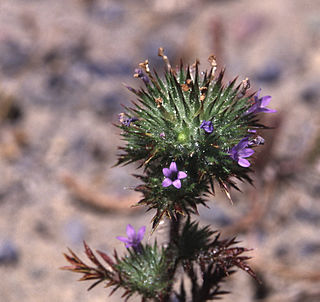
Navarretia is a genus of flowering plants related to the phloxes and the gilias. This is one genus of plants, among others, which are sometimes called pincushion plants. It includes 45 species native to the Americas. In North America they range from western Canada through the western and west-central United States to northwestern Mexico, and to Ohio and Pennsylvania. In South America they range through Argentina and Chile.
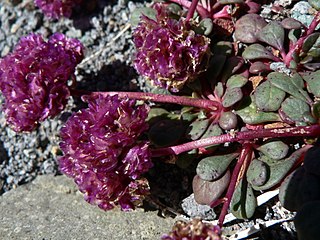
Cistanthe is a plant genus which includes most plants known as pussypaws. These are small, succulent flowering plants which often bear brightly colored flowers, though they vary quite a bit between species in appearance. Some species have flowers that are tightly packed into fluffy-looking inflorescences, the trait that gives them their common name.

Plagiobothrys is a genus of flowering plants known commonly as popcorn flowers. These are small herbaceous plants which bear tiny white or yellow flowers. Their fruits are nutlets. Although these plants are found predominantly in North America and South America, five species are known from Australia. Of the approximately 65 species described, more than 15 are endemic to California.

Tiquilia is a genus of flowering plants in the borage family, Boraginaceae. The 28 species in this genus are known by the common name crinklemat. They are native to the Western Hemisphere and are mostly found in desert regions.

Allophyllum is a small genus of flowering plants in the phlox family known as false gillyflowers. These are hairy, glandular annuals with tall, thin, branching stems topped with clusters of small tubular flowers in varying shades of purple. Some of the plants are sticky, and all have seeds which become gluey when wet. False gillyflowers are native to western North America, from Washington to Utah and northwestern Mexico.

Aliciella is a genus of plants in the phlox family. It includes 23 species native to the western United States and northwestern Mexico. These plants have been treated as members of genus Gilia until recently, when it was proposed they be moved back to Aliciella. This genus was created in 1905 to include certain gilias that seemed distinct from most of the others, but it was abandoned soon after. Later genetic analyses suggest it should be revived.
Laphamia is a genus of flowering plants in the sunflower family, Asteraceae. It includes 43 species native to the southwestern and south-central United States and northern and western Mexico.

Giliastrum is a genus of flowering plants belonging to the family Polemoniaceae.
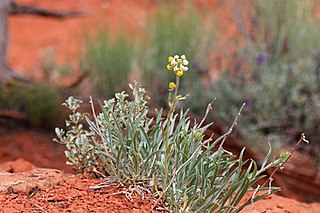
Oreocarya is a genus of flowering plants in the family Boraginaceae. There are about 63 species and its native range extends from western and central Canada, through western United States to north Mexico. It is part of subtribe of Amsinckiinae.
